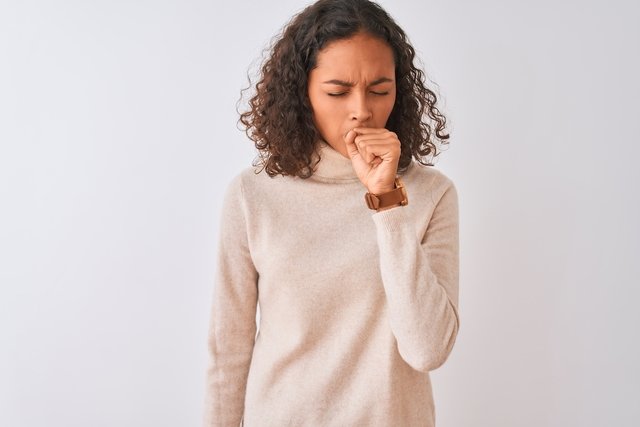Phlegm is a secretion produced by the respiratory tract, which arises due to conditions such as respiratory allergies, colds or flu, which cause transparent or whitish phlegm.
However, the color of phlegm may vary, especially when there is an infection, such as pneumonia or tuberculosis, and may become more yellowish or greenish. In addition, phlegm can also be accompanied by blood, which can be red or pink.
Regardless of the color, it is always advisable to consult a general practitioner or a pulmonologist, to identify the cause and start the most appropriate treatment, especially when there are other associated symptoms such as fever, wheezing or a feeling of shortness of breath, for example.
What does each color of phlegm mean?
The main causes for each color of phlegm are:
1. Green or yellow phlegm
These colors normally appear when neutrophils are present in the airways, which are the body’s defense cells that produce a green protein that is dissolved in the phlegm, and the color varies according to the amount of the protein. Therefore, this type of phlegm may indicate an infection of the respiratory tract or nasal sinuses, such as sinusitis or pneumonia, for example.
See what other signs may indicate a lung infection.
What to do: You should consult a pulmonologist or general practitioner to identify the type of infection that is causing the phlegm and begin appropriate treatment.
2. Bloody or red phlegm
When blood appears in the phlegm, it can be due to various diseases, from pneumonia or sinusitis, to more serious problems such as tuberculosis, pneumonia or lung cancer. Understand when it could be bronchitis.
What to do: It is necessary to consult a pulmonologist to carry out diagnostic tests, such as X-rays and microbiological culture from sputum, to identify the problem and initiate appropriate treatment, which will vary according to the diagnosis established by the doctor. The presence of blood in the phlegm is a warning sign and should always be evaluated by a doctor.
3. White or gray phlegm
This type of phlegm is generally a sign of inflammation of the upper respiratory tract, often due to viral infections, and therefore does not require antibiotic treatment. Furthermore, both the flu and sinusitis can lead to phlegm with this characteristic.
In rarer cases, this coloration can also happen when you eat a lot of dairy products, as milk derivatives make the phlegm thicker, giving it a whitish color when it is eliminated.
What to do: You should drink around 2 liters of water per day to help eliminate phlegm and, if there is no improvement, you should consult a general practitioner to begin appropriate treatment of the problem that is causing the phlegm.
In the case of the flu, for example, treatment is normally carried out with the aim of relieving symptoms, with the doctor recommending the use of Paracetamol or Ibuprofen, for example. Sinusitis can also be treated in this way, but the doctor may also recommend the use of corticosteroids or antibiotics depending on the cause of the sinusitis. It is very important in these cases to keep the upper airways hydrated by washing the nose with saline solution. Learn how to wash your nose.
4. Brown or black phlegm
Smokers and workers in places with a lot of pollution, such as mines or construction sites, generally have brown or black phlegm, which occurs due to the presence of particles such as tar or resin that stick to the respiratory tract. Just like in people who smoke, the phlegm may be dark in color.
What to do: It is recommended to avoid places with a lot of dust or pollution, as well as to stop smoking, if this is the case.
5. Pink catarrh
Coughing up pink phlegm can be an indicator that there is fluid in the lungs and is therefore very common in cases of heart problems, such as heart failure, in which blood accumulates around the lungs, causing fluid to enter the lungs. lungs.
What to do: In this case, it is important to consult a pulmonologist or general cardiologist to adapt the treatment of the problem that is causing pink phlegm, which can be done by taking specific medications in the case of heart problems.
What can change the consistency of phlegm
Normal, healthy phlegm generally has a more liquid consistency and is therefore easily reabsorbed by the body and does not make breathing difficult. However, phlegm can become thicker, especially due to situations such as:
- Being in a very dry environment, such as a room with air conditioning;
- Not drinking enough water during the day;
- Have a respiratory allergy to pollen or dust, for example;
- Taking medications that can dry up secretions, such as antidepressants, antihistamines or decongestants.
Furthermore, phlegm also becomes thicker during flu or colds, for example, but any other infection can also have this result. This happens because the body has to work harder to eliminate viruses and bacteria and, therefore, needs more water to function, leaving the phlegm drier.
Therefore, to eliminate thick phlegm, it is very important to drink around 2 liters of water per day and nebulize with water or saline solution, as this helps to fluidize the secretions and facilitate their elimination. In addition, there are some home remedies with expectorant properties that help eliminate phlegm. Find out what home remedies are available to eliminate sputum.

Sign up for our newsletter and stay up to date with exclusive news
that can transform your routine!
Warning: Undefined array key "title" in /home/storelat/public_html/wp-content/plugins/link-whisper-premium/templates/frontend/related-posts.php on line 12
Warning: Undefined array key "title_tag" in /home/storelat/public_html/wp-content/plugins/link-whisper-premium/templates/frontend/related-posts.php on line 13




